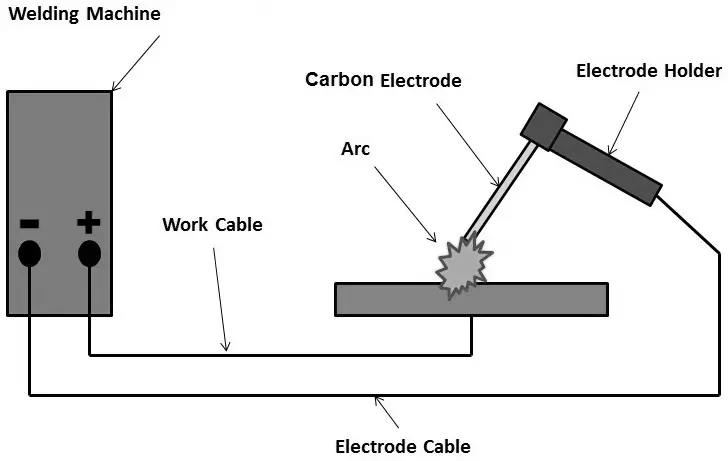Nikolay Benardos & Stanisław Olszewski, inventors, invented the first electrical welding process in 1881 called carbon arc welding. A carbon or graphite electrode is used to initiate an electric arc in this welding technique. By striking an electric arc between a carbon electrode and a workpiece to be welded, the metal pieces are heated up and welded.
What is Carbon Arc Welding?
An illustration of the carbon arc welding process is shown in the following figure.

As a part of this system, the setup consists of a carbon electrode attached to an electrode holder. During the welding process, an arc is maintained between the metal piece and the carbon electrode held within the electrode holder. Arcs are formed by touching the electrode briefly with the metal piece and then taking it away at a certain distance from the electrode.
In this process, arcs are allowed to impinge on the surface being welded until a molten pool forms, and then the holder is gradually moved along the joint. It will depend on the type of joint and the material to be welded whether or not filler metal and flux are used.
The electrode in carbon arc welding is usually connected to the negative terminal, while the workpiece to be welded is connected to the positive terminal. As a result, less heat will be generated at the electrode tip than at the metal piece since carbon particles from the electrode tend to fuse with each other and mix in the weld, causing it to be brittle.
Carbon arc welding can be performed in two ways:
1. The first method does not require the use of flux. As a result, this method of carbon arc welding can only be used on non-ferrous metals.
2. Another method uses powdered or pasted flux to prevent oxidation of the weld. As a result, this method of carbon arc welding is typically applied to ferrous metals.
For carbon arc welding, DC supplies are preferred because AC supplies do not have fixed polarity. A voltage of approximately 40 Volts is generally used in the case of a DC supply and 30 Volts in the case of an AC supply.
What are the Electrodes Used in Carbon Arc Welding?
It is common to use carbon or graphite electrodes, each measuring 2.5 mm in diameter and 300 mm in length, for carbon arc welding. Graphite electrodes have several advantages over carbon electrodes, including more brittleness, hardness, and longer life. Even though graphite electrodes are capable of withstanding higher current densities, controlling the arc column is difficult.
Graphite electrodes are preferred over carbon electrodes due to their longer life and low resistance. When an arc is created between the electrode and the metal piece, the metal is heated to its melting temperature, which is approximately 3200°C on the positive electrode.
The electrodes used are generally non-consumable carbon or graphite electrodes. It is important to note that there may be a requirement for additional filler material if necessary for welding, depending on the joint type and the materials to be welded. Therefore, this type of welding is commonly used in situations where filler material is not needed. It is important to note that despite the electrode being of a non-consumable type, vaporization and oxidation gradually cause it to disintegrate.
Advantages of Carbon Arc Welding
Carbon arc welding offers the following advantages:
1. It is possible to control the amount of heat input to the metal piece by changing the length of the arc.
2. In addition to ferrous metals, nonferrous metals can also be welded using this welding technique.
3. It is less expensive to weld using carbon arc welding than to use other welding techniques.
4. Welding of this type is suitable for joining thin pieces of metal.
5. A carbon arc welding process can be automated through the use of electronic controllers.
6. Good welding skills can be acquired relatively quickly through this method of clean welding with a simple process.
7. Carbon arc welding is the most effective method of providing heat for soldering, brazing, braze welding, etc.
Disadvantages of Carbon Arc Welding
There are several disadvantages associated with carbon arc welding, including:
1. It is possible that carbon will be transferred from electrodes to welds, resulting in a harder weld deposit when ferrous materials are used.
2. The absence of a proper electrode geometry results in arc blows that result in poor welds with blow holes.
3. The welding speed is slowed when a filler metal is used in carbon arc welding.
4. When welding, the current required to attain welding temperature is almost twice that required in metal arc welding.
5. Using a DC supply for carbon arc welding can be both efficient and economically effective.
Applications of Carbon Arc Welding
1. It can be used to weld steel, aluminum, nickel, and copper, as well as a good number of other alloys.
2. The carbon arc can also be used to braze, preheat, and post-heat welded joints.
3. It is possible to weld stainless steel of thinner gauges.
4. The welding of Monel metal with the use of suitable coated filler material can be done.

Insightful article